Five things Alice in Wonderland reveals about the brain
Lewis Carroll was remarkably modest about his masterpiece. “The heroine spends an hour underground, and meets various birds, beasts, etc (no fairies), endowed with speech,” he wrote in Punch. “The whole thing is a dream, but that I don’t want revealed till the end.”
It is now one-and-a-half centuries since Alice first made that journey – and Carroll’s humble tale has inspired countless films, paintings, and even a ballet. What is less well known is the way it shaped our understanding of the brain. Not just Freudian psychology and analysis, but modern neuroscience.
Memory, language, and consciousness: long before we had the technology to map the brain’s Wonderland, Carroll was already charting its contours with his playful thought experiments. “It explores so many ideas about whether there’s a continuous self, how we remember things from the past and think about the future – there’s lots of richness there about what we know about cognition and cognitive science,” says Alison Gopnik at the University of California, Berkeley.
All of us can learn something about ourselves from Alice in Wonderland – if only we look in the right way. As we approach the book’s 150th anniversary, BBC Future follows her journey to the brain’s outer limits.
“Drink me”
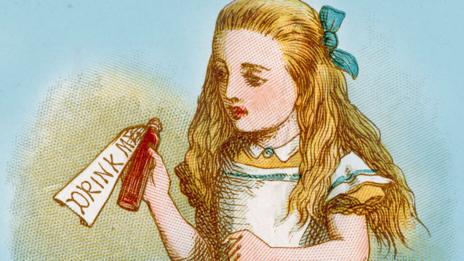
(Alamy)
“Well, I'll eat it,” said Alice, “and if it makes me grow larger, I can reach the key; and if it makes me grow smaller, I can creep under the door; so either way I'll get into the garden, and I don't care which happens!”
In one of her first adventures, Alice finds a potion with “drink me” on its label, that shrinks her to just 10 inches tall. A magic cake then has the opposite effect – she is now so big her head hits the ceiling. The scenes are among the most memorable of the book and Disney’s film adaptation – and they were among the first to grab the attention of scientists.
In 1955, a psychiatrist called John Todd found that certain patients reported exactly the same feeling of “opening out like a telescope”. The disorder is known as Alice in Wonderland Syndrome, and it seems to be most common in children. “I have heard patients saying that things appear upside down, or even though mommy is on other side of the room, she appeared next to her,” says Grant Liu, a neurologist at the University of Pennsylvania in Philadelphia who has studied the phenomenon.
Carroll’s diaries show that he suffered migraines, which often trigger the syndrome – leading some to speculate that he was using his own experiences as inspiration. Liu suspects the syndrome can be pinned to abnormal activity in the parietal lobes, which are responsible for spatial awareness, skewing the sense of perspective and distance. But despite the fact that it can be disturbing, these fleeting illusions are generally harmless. “The majority are unaffected – and we just provide reassurance that the patient is not crazy and that other people also experience these things,” says Liu. Today, neuroscientists are trying to evoke the illusion in healthy subjects – which they think might shed light on the way we create our sense of self in the here and now.
The Duchess and the Cheshire cat
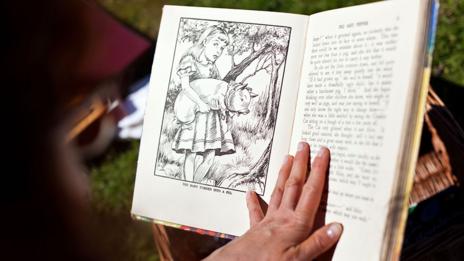
(Alamy)
This time there could be no mistake about it: it was neither more nor less than a pig, and she felt that it would be quite absurd for her to carry it further.
Wonderland is full of shapeshifting characters, including the grotesque Duchess and her crying baby. As Alice holds it in her hands, the baby’s nose becomes more upturned; its eyes grow closer together, and it starts grunting. Before she knows it, the baby has turned into a pig. Elsewhere, Alice plays croquet with flamingos as clubs, and meets the smiling Cheshire cat, whose grin remains even as his body disappears.
Dreams often contain objects morphing into new identities, and this characteristic is one of the cleverest ways that Alice’s adventures evoke the sleeping mind – along with her strange sense that time is playing tricks on her. Neuroscientists think that the phenomenon arises from the way the sleeping brain consolidates memories; as it cements the recollections, it draws links between different events to build the bigger story of our lives. When cross-referencing a memory about a pig with an event about a baby, for instance, both become merged in the dreamscape to surreal effect.
Humpty Dumpty and the Jabberwocky
Humpty Dumpty and the Jabberwocky
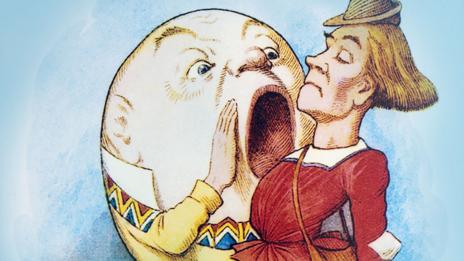
(Getty Images)
"My NAME is Alice, but—"
"It's a stupid enough name!" Humpty Dumpty interrupted impatiently. "What does it mean?"
"MUST a name mean something?" Alice asked doubtfully.
"Of course it must," Humpty Dumpty said with a short laugh: "MY name means the shape I am – and a good handsome shape it is, too. With a name like yours, you might be any shape, almost."
"It's a stupid enough name!" Humpty Dumpty interrupted impatiently. "What does it mean?"
"MUST a name mean something?" Alice asked doubtfully.
"Of course it must," Humpty Dumpty said with a short laugh: "MY name means the shape I am – and a good handsome shape it is, too. With a name like yours, you might be any shape, almost."
Alice’s adventures Through the Looking Glass continue these explorations – including some playful forays into the nature of speech.
It begins in the first chapter, when Alice reads a poem called the Jabberwocky. “Twas brilig, and the slithy toves/ Did gyre and gimble in the wabe…” the poem begins. “It seems very pretty,” Alice says when she had finished it, “but it's RATHER hard to understand!”
Alice hits the nail on the head: the poem somehow tickles our sense of grammatical correctness even though the words themselves are nonsense. Neuroscientists exploring the machinery of language now regularly use “Jabberwocky sentences” during brain scans, to show that meaning and grammar are processed quite separately in the brain. (Interestingly, other writers have also used such “grammatical nonsense” to great effect – including Kurt Cobain in Nirvana’s Smells Like Teen Spirit.)
More fundamentally, Alice then meets Humpty Dumpty, and their conversation explores the nature of words themselves. Can a two-word phrase like Humpty Dumpty evoke his “handsome shape” better than some other random sounds? This is an ancient philosophical question that dates to Plato. Previously, scientists had assumed that would be impossible – words are arbitrary and there should be no innate meaning in sounds. But it’s now looking like Humpty may have been right.
Consider the words “kiki” and “bouba”. If given different shapes to label, most people choose kiki for a sharp object and bouba for a round one. Such “sound symbolism” is now a popular area of research, though the reason is not entirely clear; one theory is that the association comes from the shapes the lips make as they articulate the sounds.
Whatever the cause, it means that you can sometimes guess the meaning of foreign words with accuracy better than chance; it can also influence the nicknames given to people, so that, like Humpty Dumpty, they actually reflect your appearance. More intriguingly, some even suspect that these could be “linguistic fossils” that reflect humankind’s first utterances.
The White Queen and mental time travel
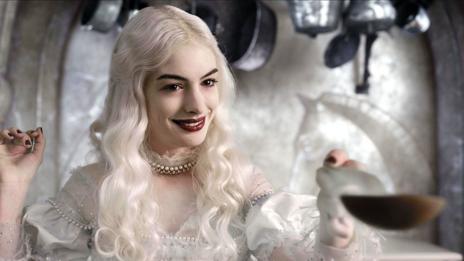
(Alamy)
“It's a poor sort of memory that only works backwards,” the Queen remarked.
“What sort of things do YOU remember best?” Alice ventured to ask.
“Oh, things that happened the week after next,” the Queen replied in a careless tone.
“What sort of things do YOU remember best?” Alice ventured to ask.
“Oh, things that happened the week after next,” the Queen replied in a careless tone.
Later on in her journey, Alice has lengthy discussions with the White Queen. She is one of Carroll’s most baffling creations, claiming to have a strange form of foresight. In fact, her comments on memory are themselves surprisingly prescient. “Since the mid-2000s neuroscientists started to realise that memory is not really about the past, it’s about helping you act appropriately in the future,” says Eleanor Maguire at University College London, who often uses the White Queen to illustrate the idea. “You need to project yourself forward to work out the best course of action.”
One possibility is that we imagine the future by pulling apart our recollections and then piecing them together in a montage that might represent a new scenario. In this way, memory and foresight use the same “mental time travel” in the the same areas of the brain. Maguire, for instance, has studied people with damage to their hippocampus; the injury means that they can’t remember their past, but she has found that they also struggle with forward thinking. “We asked them to imagine meeting a friend next weekend – and they just couldn’t do it.” The same was true when they were asked to imagine a future visit to the seaside. “They knew there would be sand and sea but couldn’t visualise it in the mind’s eye.” In other words, unlike the White Queen, they are stuck forever in the eternal present.
Can you think impossible thoughts?
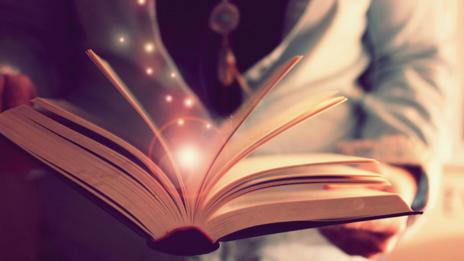
(Getty Images)
“There's no use trying,” Alice said: “one CAN'T believe impossible things.”
“I daresay you haven't had much practice,” said the Queen. “When I was your age, I always did it for half-an-hour a day. Why, sometimes I've believed as many as six impossible things before breakfast.”
“I daresay you haven't had much practice,” said the Queen. “When I was your age, I always did it for half-an-hour a day. Why, sometimes I've believed as many as six impossible things before breakfast.”
Continuing her exploration of human imagination, the Queen extolls the virtues of thinking about the impossible. The passage speaks to Gopnik, who first read Alice when she was three years old and now spends her career studying how we build our imaginations.
She has found, for instance, that children who play pretend and practice “believing the impossible” tend to develop more advanced cognition. They are better at understanding hypothetical thinking, for instance, and they tend to develop a more advanced “theory of mind”, giving them more astute understanding of other people’s motives and intentions. “A lot of what they do in pretend play is take a hypothesis and follow it out to the logical conclusion,” says Gopnik. “What’s interesting is that Carroll was also a magician and you can see that same ability to take a premise and to take it out to a crazy conclusion.”
Alice’s adventures are full of surreal encounters that could help anyone exercise these skills. Travis Proulx at Tilburg University in the Netherlands has examined the way that surreal and absurdist literature, like Carroll’s, influences our cognition. He has found that by violating our expectations in a strange, alien world, fantastical stories pushes our brains to be more flexible, making us more creative, and quicker to learn new ideas. So if you are in a rut and feel like stretching your mind, you may find no better solution than an evening with Alice. “I have no doubt it stimulates these mental states that enhance learning and motivate us to make new connections,” says Proulx.
Gopnik points out that some hallucinogenic drugs may also help you to get to the childlike state of free-association, but reading is surely the safer way to turn back the clock and see the world from a new perspective. As Carroll writes: “So many out-of-the-way things had happened lately, that Alice had begun to think that very few things indeed were really impossible.” Her readers would surely agree.
No comments:
Post a Comment